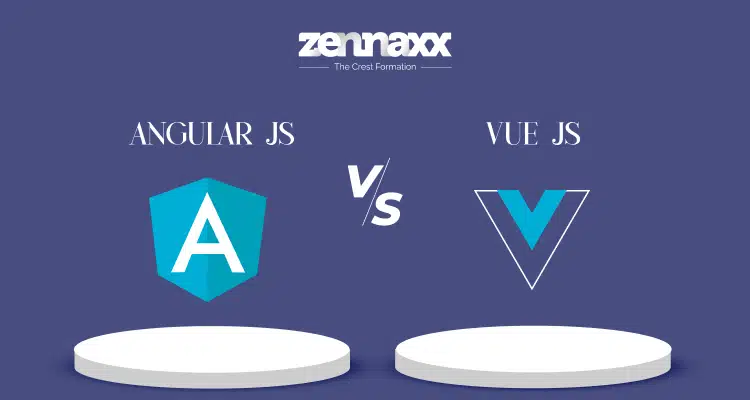Developing your front end requires more than just a library of read-to-use components!
Yes, businesses strive for rapid development and ready-made components make for a great choice.
But frontend development also needs seamless integration between model and view components. However separation of concerns is also a key aspect!
So, you need a framework that addresses all the above challenges and yet offers advanced development tools! Fortunately, Angular and VueJS both come with security, extensibility, and advanced CLI tools.
Now the question that you will have is which one to choose?
This article will help you with all the answers you need while choosing between Angular vs. VueJS.
For starters, you need to understand them individually!

What Is Angular?
Angular is a Javascript framework that allows businesses to create secure and scalable web applications.
It is based on TypeScript and has built-in tools that offer a seamless experience across screen sizes. Angular also comes with pre-built libraries that help build faster web applications.
The ease of using the code repeatedly makes Angular ideal for web app development across platforms.
Dynamic UI binding at a property level and two-way data binding from Angular cater to the needs of developing complex web applications.
History of Angular
Like every other rivalry, Angular vs VueJS also begins from their origins!
Released in 2016, Angular was a complete overhaul of AngularJS developed by Misko Hevery and the Angular team at Google. Today, the Angular community is 3,371,447 strong, with more than 1,884 contributors.
Since the release of the Angular 2 framework, semantic versioning has been adopted, with new releases scheduled every six months.
Angular 3 was the next iteration in which typescript was used instead of Javascript at the framework’s core. However, in 2017, Angular 4 was released with new capabilities like “Universal Project.”
It also came with an inbuilt animation package, ngTemplate, form validator attributes, title case pipe, and other upgrades.
Angular 5 is an improved version of Angular 4, with new features and bug fixes, including Build Optimizer and HttpClient. The incremental update of Angular 6 brought new features and upgrades.
With these releases, the Angular team has focused on Angular’s toolchains, such as ngAngular Elements, CLI Workspaces, Library Support, and Angular Material Starter Components.
Since Angular 6, there has been no significant upgrade to the framework except the following minor changes,
- Angular 9 established ng-update as a dependable service. And updates to the API extractor .
- Angular 10 came with language service and updates to the compiler.
- Angular 11 introduced TypeScript 4.0 and support for WebPack 5.0 with migration to ESLint.
- Angular 12 offered support for TypeScript 4.2 and Webpack 5.7 with the facility of migrating from legacy i18n message IDs.
Popular Web Applications Built With Angular

When comparing Angular vs VueJS, knowing practical applications matters the most. With its robust features and high performance, Angular allows enterprises to build unique user experiences.
From the Guardian to Google and Upwork, Angular has powered applications across business domains. Here are some applications that help build reliable applications.
1. The Guardian
The Guardian uses Angular and RxJS extensions to provide readers with a site loaded with rich information on almost every topic.
Developers at The Guardian used Angular to create infinite scrolling features for search results on their site.
The angular backend handles the massive load that the Guardian’s website encounters while millions of readers try to find information on the platform.
2. Gmail
Gmail leveraged Angular to build its single-page application, which loads the entire app onto a single HTML page.
The Gmail team also used Angular to add dynamic updates. So, wherever new messages occur, Gmail sends updates in real-time to users.
With two-way data binding capabilities, Angular has been pivotal for Gmail in providing offline access to users.
Angular also allows Gmail to display email messages, labels, and other front-end data efficiently.
3. PayPal
Paypal used Angular to build web platform, which allows faster and more responsive user interfaces.
On the front end, Angular has proven pivotal for PayPal’s complex user interface. It will enable PayPal’s team to manage data binging and user interactions better.
Further, PayPal’s team uses Angular’s modular architecture to create reusable components, which allows PayPal developers to maintain and scale applications.
4. Forbes
Forbes uses Angular to create user-friendly UI and cater to millions of users. With the flexibility of rapid prototyping and reusable components, Angular allows Forbes to implement changes to its website quickly.
The Forbes team uses Angular to auto-update the article, maintaining a consistent look and feel across the website.
5. Upwork
Its team also uses a robust framework to ensure smooth interactions and real-time user communication.
The platform connects businesses and professionals with a responsive single-page experience.
Angular allows Upwork to develop a high-performing, responsive platform that can cater to the needs of millions.
What Is VueJS?
VueJS is a JavaScript-based framework that offers advanced web tools for developing modern SPAs. It can also be Used to build front-end web apps with greater flexibility.
VueJS is a lightweight framework that allows you to easily add new updates to apps without disrupting the core app operations.
It also provides an opportunity to create progressive UI for your web applications.
VueJS offers decoupling capabilities, which separate a web app’s front and back end. This makes the entire app scalable and flexible to changes.
So, if you add modifications to the front or back end, they do not affect the whole application.
History
First, it was the defender(Angular), and now, it is the contender in this Angular vs VueJS rivalry!

VueJS is an open-source framework based on JavaScript developers use to build interactive web interfaces. Companies use VueJS for functional UI development for websites and single-page applications.
Developed by Evan You in February 2014, VueJS has become one of the popular frameworks for front-end development. Here is the timeline for VueJS releases.
- In 2015, the first version, VueJS 1.0, was released under “Evangelion.”
- The second version, “Ghost in the Shell” or VueJS 2.0, was released in 2016.
- In 2020, another major release called “One Piece” was introduced, also known as VueJS 3.0
- The last known release for the VueJS was 3.4, released on December 28, 2023.
Popular Web Applications Built With VueJS
VueJS has been the framework choice for many leading applications in the market, including
1. Gitlab
GitLab used VueJS to implement complex features and improve reporting, administration, code management, and analytics.
The GitLab team migrated to VueJS, slowly creating advanced components without much manual effort.
GitLab uses VueJS in combination with Nuxt for specific parts of its application. Further, developers at GitLab create regular HTML pages augmented with VueJS components.
2. Grammarly
Grammarly uses VueJS to build intuitive features for users. Dynamic features that indicate grammatical mistakes needed a robust framework, so Grammarly chose VueJS’s data binding and template engine capabilities.
Further, the Grammarly team created an interface that was easy to use. The user-friendly editor made with VueJS provides a simplistic design and a contextual structure.
3. Laravel Spark
Laravel Spark uses VueJS to facilitate the seamless functioning of front-end applications. It uses VueJS to incorporate custom-built components, which allows the Laravel Spark to create complex features.
Using VueJS allows Laravel Spark to improve user interaction and experience on their SaaS applications.
4. Behance
Behance uses Angular to build portfolio websites for users that display projects in real time.
The ngx-behance package supports integrating Behance API with Angular, making it easier to create portfolio sites and showcase projects.
Further, Behance, which is part of Adobe Creative Cloud, provides uniform app code and standardized visual features with Angular.
The platform offers a visually aesthetic interface, allowing professionals to showcase projects in graphic design, illustration, fashion, photography, advertising, fine arts, and game design.
5. Nintendo
VueJS facilitates engaging and interactive experiences on the Nintendo website for their loyal gaming community.
It is a progressive framework for building user interfaces and one-page applications. which ensures that visitors to the Nintendo website can seamlessly browse games.
Want to Automate Your Business Process With a Software Solution?
Zennaxx, a leading software development firm in Canada, has delivered 700+ bespoke solutions spanning various industries.
Main Features of Angular
- Component-based architecture- Angular uses an architecture with a hierarchy of components that helps businesses build scalable applications.
- MVC structure- Angular leverages Model-View-Controller to allow developers to divide apps into sections and create code to connect separate components.
- Two-way data binding- It allows the app system to sync data between model and view components seamlessly, making the user experience enhanced.
- CLI (Command-Line Interface)- The Angular CLI allows you to initialize, develop, scaffold, and maintain applications with custom commands.
- Dependency injection- Angular has a built-in dependency injection subsystem, which you can use to create reusable code reducing manual efforts.
- RxJS- You can use this library to implement reactive programming, which leverages observables and easily comprises asynchronous code.
- Forms and routing- Angular allows you to manage seamless forms and navigation, which is crucial for developing high-performance single-page applications.
Main Features of VueJS
- Reactive state management- VueJS has a reactive data model that automatically updates the view when the app’s state changes.
- Component-based development- You can use VueJS to leverage a component-based development model to build reusable UI components.
- Virtual DOM implementation- You can implement a virtual DOM to ensure better rendering of user interface components with VueJSt.
- Template syntax- The simple templating syntax of VueJS allows you to extend HTML with declarative data binding, making the entire app experience efficient.
- Seamless integration- You can adopt VueJS incrementally with the ease of integrating multiple third-party services and applications.
- CLI tools- VueJS provides CLI tools that make development rapid and provide debugging capabilities to ensure enhanced web app performance.
Angular vs VueJS: Similarities and Common Features
When comparing Angular vs. VueJS, knowing the similarities and standard features is crucial. So, here is a comprehensive list of similarities between Angular and VueJS
Angular vs. Vue: Which One Is Better?
Angular and VueJS excel at different aspects of frontend development, such as project scale, ease of learning, performance requirements, and specific use cases.
1. Popularity and Job Market
The Angular vs. VueJS comparison needs an analysis of the popularity of both frameworks in the job market.
When it comes to popularity, Angular is used by more than 0.4% of all websites on the internet. It is also widely used by more than 7.21% of developers worldwide.
On the other hand, VueJS is currently used by more than 2,225,642 websites worldwide. It also has a market share of 0.8%.
However, if you compare the job market listings across job boards, Angular has the upper hand on VueJS.
2. Learning Curve
Angular is a vast, dynamic framework with a steeper learning curve. At the same time, VueJS is easy to learn.
Angular requires developers to have command of JavaScript. However, Angular CLI does offer a linear learning curve, which makes it a little easier for developers.
VueJS, on the other hand, needs a basic understanding of ES6’s functioning and fundamental JavaScritpt knowledge. It also has easy-to-learn and understandable documentation.
3. Performance (Speed)
A comparison of Angular vs. VueJS performance is crucial if you select a framework for developing your web apps.
If a single component changes, Angular uses real DOM to render the entire web app page.
VueJS leverages virtual DOM, which renders the real DOM only when specific components change. This helps developers improve application performance and speed.
4. Components and Extensibility
Angular offers a set of highly extensible components that integrate well with each other. Its component management system is effective in managing large-scale applications.
It also provides maintainable code, improving developers’ productivity. In contrast, Vue simplifies extensibility and is centered around reactive and declarative rendering.
5. State Management
Angular allows you to manage complex application data flows to ensure a seamless user experience.
Another significant aspect of Angular that makes it attractive is the integration of RxJS, which makes state management efficient.
VueJS leverages Vuex to enable stage management for your web apps. It also provides a lightweight approach to state management, making it less complex.
6. Ecosystem
Angular has a well-developed ecosystem supported by Google, which includes a diverse range of tools, libraries, and community support.
This vast ecosystem benefits developers seeking extensive resources and community-backed solutions.
VueJS has a small but rapidly growing, vibrant, innovative ecosystem thanks to community contributions.
7. Security
Both frameworks offer similar security features to safeguard web applications against common web vulnerabilities such as XSS and CSRF. However, Angular has a slight advantage over VueJS.
It has stringent development practices, focusing on building web applications with a high priority on security standards. VueJS is also secure but relies more on community standards and plugins.
8. Testing and Debugging
You can easily integrate Angular with testing tools such as Jasmine and Protractor, which provide various end-to-end test capabilities.
This integration makes setting up and performing unit, integration, functional, and other tests easier.
9. Support and Community
Due to its longstanding presence and adoption in various large-scale applications, Angular has a vast and active community.
This community contributes to Angular tutorials, third-party tools, plugins, and professional forums. Angular’s community comprises mostly professional developers and enterprises, with well-maintained documentation by Google.
In comparison, VueJS has a smaller community that focuses on new beginners. It offers community-driven projects, forums, and third-party plugins that help beginners develop apps rapidly.
At the end of this comprehensive comparison between Angular vs. VueJS, you can observe Angular having an edge over VueJS.
However, like any other framework, Angular and VueJS have some drawbacks.
Struggling to decide between Angular and Vue JS?
Let’s clear the fog together. Contact us to get personalized guidance and make the right choice for your project!
Drawbacks of Angular vs. VueJS
Angular and VueJS have specific limitations you need to understand before making a decision. For example, Angular has a steeper learning curve than VueJS but has a better community.
Angular’s MVC structure is another aspect in which It has an advantage over VueJS.
However, regarding lightweight framework options, Angular is stiffly competitive with VueJS.
Summary
The comparison between Angular vs. VueJS is crucial because both these frameworks have several similarities of component-based structure and two-way data binding.
However there are differences of performance, ecosystem and security that you need to consider before choosing one of them.
All things considered, Angular does seem a better option for large-scale projects while VueJS is best suited for small scale ones.


